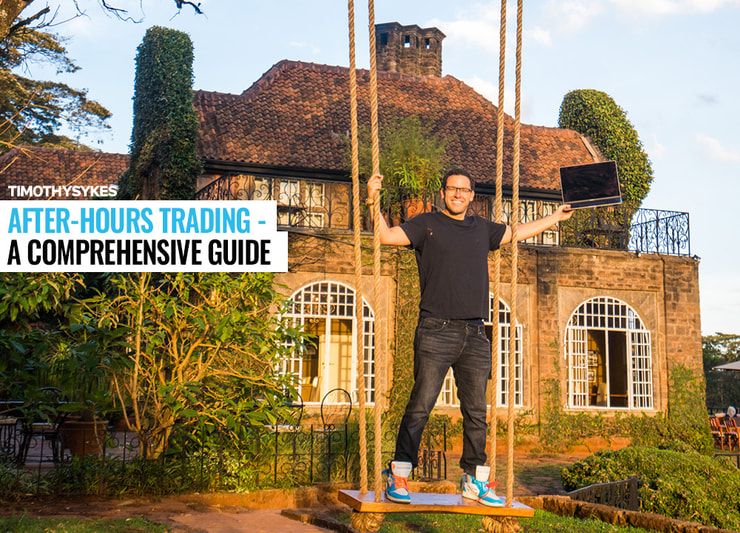After-hours trading is the period of trading that happens when the closing bell rings. On the Wall Street stock exchanges like the NYSE and Nasdaq, after-hours trading goes from 4 p.m. to 8 p.m. Eastern. It’s the time when investing businesses and services clock out, and most people don’t trade their investments.
Trading exchanges are the same as any other marketplace: they have opening and closing times. Traders need to know when to show up and when to leave, right?
If you’re just starting out as a stock trader, one of the first things you need to know is when to trade. In this article, I’ll talk about the restrictions on after-hours trading, and the bottom line on its trading purposes.
Table of Contents
- 1 What Is After-Hours Trading?
- 2 Who Can Trade After Hours?
- 3 How to Get Access to After-Hours Trading?
- 4 Preparing to Trade After Hours
- 5 Placing an Order During Extended Hours
- 6 Factors to Consider for Successful After-Hours Trading
- 7 Standard Trading Vs After-Hours Trading – Understanding the Differences
- 8 How Does After-Hours Trading Affect the Stock Price?
- 9 How To Be Successful in After-Hours Trading
- 10 Key Takeaways
What Is After-Hours Trading?

After-hours trading refers to the buying and selling of securities outside of the standard trading hours of the major exchanges, such as the NYSE and Nasdaq. It takes place in what’s known as the extended-hours market, which includes both the pre-market session in the morning and the after-hours session in the evening.
This extended-hours market is facilitated by electronic communication networks (ECNs), which are computerized systems that automatically match buy and sell orders. ECNs have made after-hours trading information and data more accessible to individual investors, who were previously largely excluded from these markets.
Benefits of After-Hours Trading
One of the main benefits of after-hours trading is the ability to react to news events that occur outside of regular market hours. This can include earnings reports, economic indicators, and other significant events that can have a major impact on a stock’s price.
For example, if a company releases a positive earnings report after the market closes, you can potentially buy the stock in the after-hours market and then sell it for a profit when the market opens the next day. This ability to act quickly on news events can give you a significant advantage over other investors.
Risks of After-Hours Trading
However, after-hours trading also comes with its share of risks. These include lower liquidity, higher volatility, and wider spreads.
Lower liquidity means there are fewer buyers and sellers in the market, which can make it more difficult to buy or sell shares. Higher volatility means prices can change rapidly and unpredictably. Wider spreads mean there is a larger difference between the bid price (what buyers are willing to pay) and the ask price (what sellers are willing to accept), which can make it more difficult to execute trades at favorable prices.
Who Can Trade After Hours?
In the past, after-hours trading was primarily the domain of large institutional investors. However, with the advent of electronic communication networks (ECNs), individual investors now have the ability to trade after hours as well.
This has leveled the playing field to some extent, but it’s important to note that institutional investors still have certain advantages in the after-hours market. For example, they often have access to more sophisticated trading tools and resources, and they can have a significant impact on the market due to the large size of their trades.
To better understand these tools and resources, consider exploring this guide on the best trading platforms for day traders.
How to Get Access to After-Hours Trading?

To get access to after-hours trading, you’ll need to have an account with a brokerage firm that offers this service. Many online brokerages, such as E-Trade and TD Ameritrade, offer after-hours trading to their customers.
When choosing a brokerage for after-hours trading, it’s important to consider factors such as the firm’s trading hours, fees, and the types of orders you can place. It’s also a good idea to test out the firm’s trading platform in the after-hours market using a virtual or demo account before you start trading with real money.
Preparing to Trade After Hours
Before diving into the world of after-hours trading, it’s essential to prepare adequately. This includes understanding the latest news, comprehending the fundamentals of the companies you’re interested in, and staying on top of market trends. It’s also crucial to understand the specific characteristics of after-hours trading. For instance, knowing how lower liquidity and higher volatility can impact stock prices is key. To get a solid foundation, check out this guide on day trading basics.
More Breaking News
- Neumora Therapeutics’ Stock: A Rollercoaster Capable of Surprising Us All
- Insights on Canaan Inc.’s Stock Surge: What’s Driving the Growth?
- Is SoFi Technologies Riding a Financial Wave or Facing Unsteady Waters?
Research the Market
Just like with regular trading, it’s crucial to do your homework before you start trading after hours. This includes keeping up with the latest news, understanding the fundamentals of the companies you’re interested in, and staying on top of market trends.
You should also familiarize yourself with the specific characteristics of the after-hours market. For example, you should understand how the lower liquidity and higher volatility can impact the prices of stocks, and how the wider spreads can affect the execution of your trades.
Different investment vehicles function differently in the after-hours period. Bonds, CDs, and ETFs may all have different fees and liquidity. Penny stocks and stocks on the Dow Jones will behave differently. Even mortgage rates change differently here!
Develop a Trading Strategy
Having a solid trading strategy is key to success in after-hours trading. This includes setting clear goals, defining your risk tolerance, and determining how much capital you’re willing to invest.
Your strategy should also include specific guidelines for entering and exiting trades. For example, you might decide to only enter trades based on certain technical indicators or news events, and to exit trades when you’ve reached a certain profit target or loss limit.
For more insights on creating a robust strategy, check out this guide on day trading strategy.
Assess the Volume and Price Movements
Volume and price movements can be significantly different in the after-hours market compared to the regular market. It’s important to understand these differences and how they can impact your trades.
For example, lower volume can lead to higher volatility, which can result in larger price swings. This can create opportunities for profit, but it can also increase the risk of losses. Similarly, larger price movements can result in wider spreads, which can make it more difficult to execute trades at favorable prices.
Choose an Appropriate Brokerage Firm
Not all brokerage firms offer after-hours trading, and those that do may have different rules and fees. It’s important to choose a brokerage firm that fits your needs and understand their policies regarding after-hours trading.
For example, some firms may only offer after-hours trading on certain exchanges or for certain types of securities. They may also have different trading hours, order types, and fee structures for after-hours trading. Be sure to read the firm’s after-hours trading agreement and disclosure documents carefully before you start trading.
Placing an Order During Extended Hours

When it comes to trading a security during extended hours, there are a few things you should know before spending your hard-earned cash…
Connect to Electronic Communication Network (ECN)
To trade after hours, you’ll need to connect to an ECN, which is a type of computer system that facilitates trading outside of regular market hours. Your brokerage firm can provide you with access to an ECN.
When placing an order through an ECN, it’s important to understand that your order will be competing with orders from other traders, including institutional investors. This means that you may not always be able to execute your trades at your desired prices.
Consider Fees for Extended Hours Trades
Trading after hours can come with additional fees. These can include ECN fees, extended hours trading fees, and others. It’s important to understand these fees and take them into account when calculating your potential profits and losses.
For example, if your brokerage firm charges a fee for each share traded in the after-hours market, this could significantly reduce your profits on small trades. Similarly, if the firm charges a minimum fee for each after-hours trade, this could make it less cost-effective to place small trades.
Understand Pre-Market and Post-Market Trading Sessions
The extended-hours market is divided into two sessions: the pre-market session, which takes place in the morning before the regular market opens, and the post-market session, which takes place in the evening after the regular market closes. Each session has its own unique characteristics and risks.
For example, the pre-market session can be influenced by news events that occur overnight, such as economic reports from other countries. The post-market session can be influenced by news events that occur after the regular market closes, such as earnings reports.
Monitoring Your Trade During Extended Hours
Once you’ve placed your trade, it’s important to monitor it closely. This includes keeping an eye on the stock’s price, volume, and other key indicators, as well as staying on top of any news events that could impact the stock.
Monitoring your trade can help you make informed decisions about when to exit the trade. For example, if the stock’s price starts to move against you, you might decide to cut your losses and sell the stock. Conversely, if the stock’s price starts to move in your favor, you might decide to take your profits and sell the stock.
Factors to Consider for Successful After-Hours Trading

When it comes to after-hours trading, there are a few key factors to consider to see the results you’re targeting.
Volume
Volume is a measure of how much of a particular stock is being traded. In the after-hours market, volume can be significantly lower than during regular market hours, which can lead to higher volatility and wider spreads.
Understanding volume patterns in the after-hours market can help you make more informed trading decisions. For example, if a stock has high volume in the after-hours market, this could indicate strong investor interest and could potentially lead to larger price movements.
Price
Price movements can be more volatile in the after-hours market due to lower liquidity and fewer participants. It’s important to understand these price movements and how they can impact your trades.
For example, if a stock’s price is moving rapidly in the after-hours market, this could indicate high volatility, which could increase the risk of your trade. Conversely, if a stock’s price is relatively stable in the after-hours market, this could indicate lower volatility, which could reduce the risk of your trade.
Participation
The number of participants in the after-hours market can be much lower than during regular market hours. This can result in less competition, but it can also make it more difficult to buy or sell shares at your desired price.
Understanding the level of participation in the after-hours market can help you gauge the liquidity of a particular stock. For example, if a stock has a high level of participation in the after-hours market, this could indicate good liquidity, which could make it easier to execute your trades.
Standard Trading Vs After-Hours Trading – Understanding the Differences

While there are many similarities between standard trading and after-hours trading, there are also some key differences. These include differences in liquidity, volatility, and trading rules. It’s important to understand these differences before you start trading after hours.
For example, liquidity can be much lower in the after-hours market, which can lead to higher volatility and wider spreads. Additionally, most brokerage firms only allow limit orders in the after-hours market, which can limit your flexibility in executing trades.
How Does After-Hours Trading Affect the Stock Price?
After-hours trading can have a significant impact on a stock’s price. This is because the price of a stock is determined by supply and demand, and in the after-hours market, there can be significant changes in supply and demand due to news events, analyst statements, and other factors.
For example, if a company releases a positive earnings report after the market closes, this could increase demand for the stock in the after-hours market, which could drive up the stock’s price. Conversely, if a company releases a negative earnings report, this could decrease demand for the stock, which could drive down the stock’s price.
How To Be Successful in After-Hours Trading
Success in after-hours trading comes down to preparation, strategy, and risk management. This includes doing your homework, having a solid trading strategy, understanding the risks, and being prepared to adjust your strategy as market conditions change.
For example, you should always do your research before you start trading in the after-hours market. This includes understanding the fundamentals of the companies you’re interested in, keeping up with the latest news, and understanding the specific characteristics of the after-hours market.
Key Takeaways

After-hours trading offers a unique opportunity for investors to trade outside of regular market hours. However, it also comes with its own set of risks and challenges. By understanding these risks and preparing accordingly, you can increase your chances of success in the after-hours market.
Trading isn’t rocket science. It’s a skill you build and work on like any other. Trading has changed my life, and I think this way of life should be open to more people…
I’ve built my Trading Challenge to pass on the things I had to learn for myself. It’s the kind of community that I wish I had when I was starting out.
We don’t accept everyone. If you’re up for the challenge — I want to hear from you.
Apply to the Trading Challenge here.
Trading is a battlefield. The more knowledge you have, the better prepared you’ll be.
Do you trade after-hours? Let me know in the comments — I love hearing from my readers!



Leave a reply